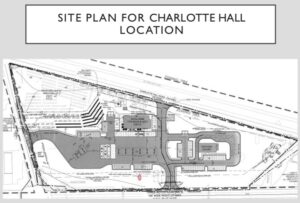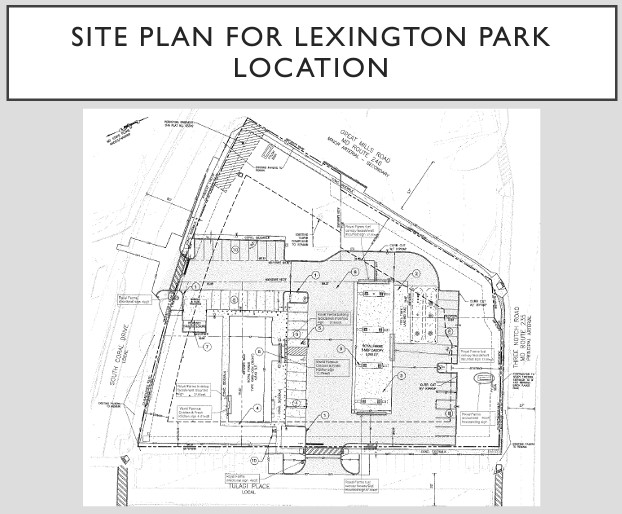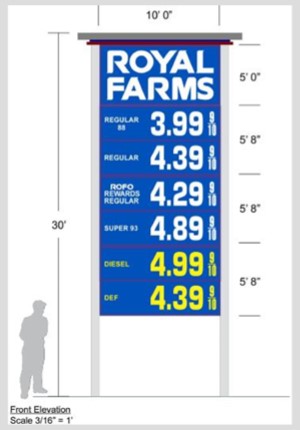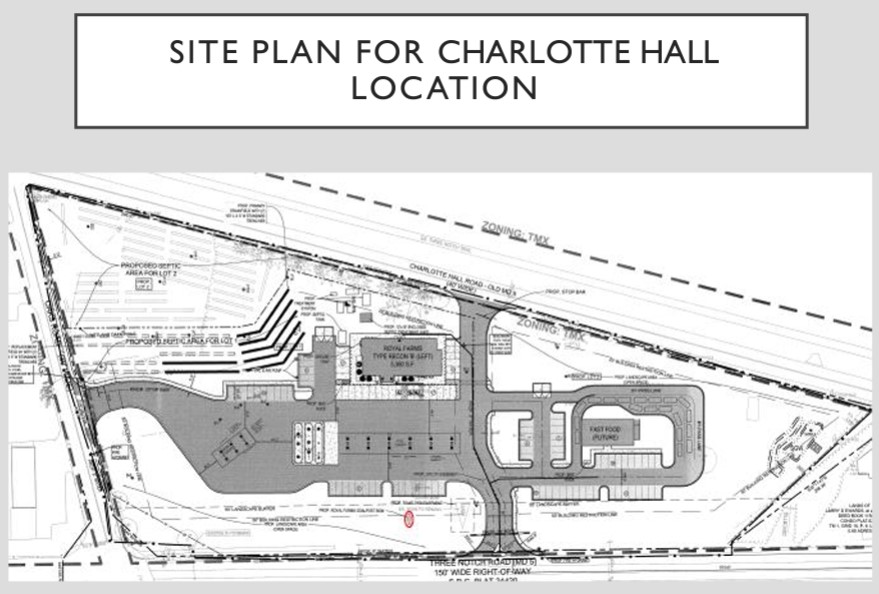 The St. Mary’s County Board of Appeals convened to review and deliberate on conditional use and variance requests submitted by Royal Farms for signage at two new store locations in Charlotte Hall and Lexington Park. Both applications sought approval to exceed the county’s 20-foot height limit for freestanding signs—requesting a 30-foot sign in Charlotte Hall and a 27-foot sign in Lexington Park. Additionally, Royal Farms requested variances to increase the allowable sign face area from 32 square feet to 50 square feet. Attorney Chris Longmore represented Royal Farms, providing justifications for the sign height and area increases in both cases. The Board carefully considered the arguments from the applicant, public comments, and zoning ordinance standards before making their decisions.
The St. Mary’s County Board of Appeals convened to review and deliberate on conditional use and variance requests submitted by Royal Farms for signage at two new store locations in Charlotte Hall and Lexington Park. Both applications sought approval to exceed the county’s 20-foot height limit for freestanding signs—requesting a 30-foot sign in Charlotte Hall and a 27-foot sign in Lexington Park. Additionally, Royal Farms requested variances to increase the allowable sign face area from 32 square feet to 50 square feet. Attorney Chris Longmore represented Royal Farms, providing justifications for the sign height and area increases in both cases. The Board carefully considered the arguments from the applicant, public comments, and zoning ordinance standards before making their decisions.
Below is a comprehensive summary of the discussions, arguments, and decisions from the meeting.
Case 1: Royal Farms – Charlotte Hall
Applicant’s Key Points:
- District Standards Compliance: Royal Farms argued that the 30-foot sign complied with the commercial district’s standards and was in line with other commercial uses in the area. Mr. Longmore explained that Charlotte Hall is a heavily trafficked commercial hub, making the larger sign height appropriate and necessary to ensure visibility for drivers along busy thoroughfares.
- Appropriate Location and Ordinance Interpretation: The sign ordinance allows signs to reach 30 feet through conditional use approval, and Royal Farms contended that the height increase was anticipated by the county when drafting the ordinance. The applicant emphasized that Charlotte Hall’s commercial nature and traffic patterns justified the request. The sign would not cause harm or lower property values but would rather enhance the business’s visibility without detracting from the district’s overall aesthetic.
- Safety and Public Benefit: Mr. Longmore emphasized that increasing the sign height from 20 to 30 feet would improve visibility, especially for drivers traveling at higher speeds along state highways. The sign would display fuel prices clearly, which the applicant argued was a public benefit as it helps consumers make informed decisions. Royal Farms also assured the Board that the additional height would not pose any safety risks, such as traffic hazards, and that the sign was fully compliant with state regulations requiring legibility at a certain distance.
- Commercial Consistency: The applicant also pointed out that other similar businesses in the area, such as gas stations and convenience stores, already have signs of similar heights. This was presented as evidence that the increased height would not be out of place or cause visual clutter but would blend with the existing commercial landscape.
- Compliance with Eight Conditional Use Standards: Mr. Longmore methodically addressed the eight conditional use standards required by the zoning ordinance, asserting that the proposed sign met all of them. These included safety, traffic flow, public welfare, and compliance with the comprehensive plan. He argued that there was no substantial difference in public impact between a 20-foot sign and a 30-foot sign and that the additional height was necessary for optimal visibility in this commercial zone.
Board Discussion and Concerns:
- Ordinance Interpretation: Board members sought clarification on whether the ordinance allows sign height increases purely based on the conditional use standards or whether the elevation of the land must also be a factor. Mr. Longmore explained that the ordinance provides two pathways: one through elevation differences and the other through conditional use approval, which Royal Farms was seeking.
- Driver Visibility and Font Size: Concerns were raised about whether drivers would be able to safely read all six fuel price listings on the proposed sign, particularly given that the area has a speed limit of 55 mph. The applicant reassured the Board that the design adhered to state-mandated legibility requirements, which included the size of the text and placement of the sign at a stoplight for easier viewing.
Board’s Decision:
The Board unanimously approved the conditional use request to increase the sign height from 20 to 30 feet for the Charlotte Hall location, deeming it consistent with the zoning ordinance and appropriate for the commercial nature of the area. The variance for the distance between the two signs on the property was denied, indicating that while the height increase was acceptable, spacing between the signs needed to conform to the ordinance’s requirements.
Case 2: Royal Farms – Lexington Park
Applicant’s Key Points:
- Unique Site Configuration: The Lexington Park site is bordered by four roads: Great Mills Road, Route 235 (Three Notch Road), South Coral Drive, and Tulagi Place. Royal Farms emphasized that the higher-speed roads (Great Mills and Route 235) justified the need for larger and taller signs, even though the site’s entrance is off lower-speed roads (South Coral and Tulagi Place). The applicant argued that because the signs would face the higher-speed roads, the increase in height and size was essential for visibility.
- Safety and Pedestrian Considerations: The sign design includes a 7-foot clearance at the base, allowing for improved visibility of pedestrians and vehicles. The applicant argued that lowering the sign to meet the 20-foot limit would reduce pedestrian safety by obstructing sightlines. The clearance is especially important given the volume of pedestrian traffic in the area near Patuxent River Naval Air Station and surrounding businesses.
- Compliance with State and Local Requirements: As with the Charlotte Hall case, Royal Farms stressed that the sign’s height and design were compliant with state laws governing legibility for fuel prices. The increased sign face area was necessary to accommodate the branding and display of different fuel products, as required by state law.
- Variance Justification: Royal Farms explained that the variance to increase the sign face area from 32 square feet to 50 square feet was justified by the site’s unique layout. Since the sign faced faster-moving roads, the increased size would improve visibility. The applicant also noted that if the entrance had been located directly off Great Mills or Route 235, the ordinance would have allowed a larger sign face area without the need for a variance.
Community Feedback:
- Concerns About Visual Clutter and Aesthetics: Local residents, including Troy Cohen and Joan Sullivan Cowen, expressed concerns that the increased sign height would contribute to visual clutter in the area, which is undergoing revitalization efforts. They pointed out that other businesses, such as a nearby 7-Eleven, comply with the 20-foot height limit and that allowing a taller sign for Royal Farms would create inconsistency in the community’s aesthetic.
- Safety Concerns: Mr. Cohen also raised concerns about the distraction that a 27-foot sign might cause for drivers, especially given the heavy traffic near the base and the surrounding residential areas. He recommended a reduction in height to 15 feet to keep drivers’ eyes focused on the road and reduce distractions.
Board Discussion and Concerns:
- Consistency with Local Development Efforts: A Board member asked whether Royal Farms had considered lowering the sign on Great Mills Road to maintain consistency with other businesses and support the area’s revitalization efforts. The applicant responded that while Royal Farms could reduce the height, they believed the 27-foot height with a 7-foot clearance provided optimal safety for pedestrians and traffic visibility.
- Safety vs. Aesthetics: The Board discussed the balance between aesthetics and safety, acknowledging that while a lower sign might align better with other businesses, the clearance under the sign was crucial for ensuring visibility in a high-traffic, pedestrian-heavy area.
Board’s Decision:
The Board unanimously approved the request for a 27-foot sign height and an increased sign face area of 50 square feet for the Lexington Park location. The decision was contingent on receiving final approval from the State Highway Administration, given the site’s proximity to state roads. The Board acknowledged community concerns but emphasized that safety and visibility took precedence.
Conclusion:
In both cases, the Board of Appeals approved Royal Farms’ requests for taller and larger signs. The Board found that the proposed signage met the county’s conditional use standards, did not pose a risk to public safety, and was appropriate given the commercial nature of both locations. Although community members expressed concerns about the visual impact of the signs, the Board prioritized safety, visibility, and compliance with state laws in its decision-making process. The Lexington Park approval was conditional upon further review by the State Highway Administration to ensure compliance with road safety standards.





